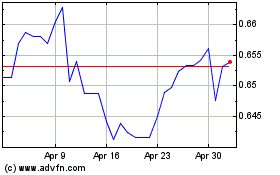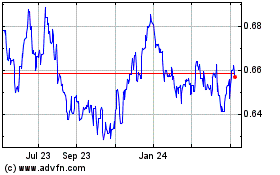Dollar Drops On China Virus Fears
January 31 2020 - 4:42AM
RTTF2
The U.S. dollar declined against its major counterparts in the
European session on Friday, as the outbreak of the coronavirus is
rapidly spreading outside China, raising concerns about the global
economy.
The Chinese National Health Commission said that 213 people have
died from the coronavirus, while the number of confirmed cases has
risen to more than 9,800.
The U.K. and Russia have also confirmed their first cases of
coronavirus infection, triggering fears about the economic impact
of the disease.
Data from the Commerce Department showed that U.S. personal
income increased slightly more than anticipated in the month of
December.
The report said personal income rose by 0.2 percent in December
after climbing by a downwardly revised 0.4 percent in November.
The greenback trended higher against its most major rivals in
the Asian session.
The greenback slipped to 108.84 against the yen, after rising to
a 2-day high of 109.14 in the Asian session. The next possible
support for the greenback is seen around the 106.00 level.
Data from the Ministry of Economy, Trade and Industry showed
that Japan retail sales rose a seasonally adjusted 0.2 percent on
month in December.
That was shy of expectations for a gain of 1.2 percent following
the 4.5 percent jump in November.
The greenback declined to an 8-day low of 0.9670 versus the
franc from yesterday's closing value of 0.9695. The greenback is
seen finding support around the 0.95 region.
Data from the Federal Statistical Office showed that
Switzerland's retail sales rose for the fourth month in a row in
December.
Retail sales rose a working-day adjusted 0.1 percent
year-on-year in December, following a 0.5 percent increase in
November.
The greenback hit a weekly low of 1.1053 against the euro from
Thursday's closing quote of 1.1031. If the greenback extends
decline, 1.12 is possibly seen as its next support level.
Preliminary data from Eurostat showed that Eurozone inflation
accelerated for the third straight month in January.
Inflation rose to 1.4 percent from 1.3 percent in December. The
rate came in line with expectations.
After rising to near a 2-month high of 1.3245 versus the loonie,
the greenback briefly pulled back to 1.3222. On the downside, 1.30
is possibly seen as the next support level for the greenback.
The greenback retreated to 0.6471 against the kiwi and 0.6704
against the aussie, from its early near a 2-month high of 0.6454
and near a 4-month high of 0.6683, respectively. The greenback may
challenge support around 0.66 against the kiwi and 0.71 against the
aussie, if it slides again.
After a brief pause, the greenback fell to a weekly low of
1.3145 against the pound. Further weakness in the currency may
locate support around the 1.33 level.
Data from the Bank of England showed that UK mortgage approvals
rose to the highest level in two-and-a-half years in December.
The number of mortgages approved in December rose to 67,241 from
65,514 in November. This was also above the forecast of 65,600.
The University of Michigan's final consumer sentiment index for
January is due out at 10:00 am ET.
AUD vs US Dollar (FX:AUDUSD)
Forex Chart
From Mar 2024 to Apr 2024

AUD vs US Dollar (FX:AUDUSD)
Forex Chart
From Apr 2023 to Apr 2024
